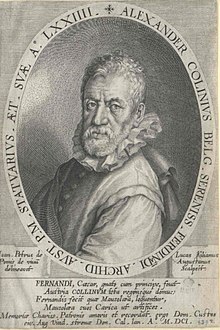Alexander Colin
Alexander Colin (also Colyn , Colins , Colyns or Collin * 1527 / 1529 in Mechelen (Antwerp Province); † 17th August 1612 in Innsbruck ) was a French sculptor and carver of Mannerism .
biography
Little is known about his youth and education and it is only suspected that he worked temporarily in France and Italy. In 1558, as a well-established artist, he took on the commission for the figurative decorations on the Ottheinrichsbau of Heidelberg Castle . Around 1560 he returned to Mechelen and married Marie de Vleeschouwer there . At the end of 1562 he entered the Habsburg service and moved to Innsbruck , which became the center of his life for the rest of his life.
His first major commission there is the continuation of the sculptures and figures for the tomb of Emperor Maximilian I (HRR) in the Innsbruck Court Church. Other important commissions for the court sculptor were the tomb of Archduke Ferdinand of Tyrol and his first wife Philippine Welser . In 1607 he created the tomb for Hans Georg III in the church Maria Laach am Jauerling . from Kuefstein. Likewise the tombstone of Bishop Johann Nas with the life-size picture of the same and also his own tombstone in the Innsbruck cemetery, depicting the awakening of Lazarus .
He was commissioned to manufacture two fountains for the Neugebuilding Castle . One of them is probably on the ground floor of the Schönbrunn Orangery.
The discovery of the marble quarries in Obernberg am Brenner is also counted among his merits .
Honors
Colingasse in downtown Innsbruck was named after Alexander Colin . On the facade of the Tyrolean Provincial Museum Ferdinandeum , completed in 1884, you can find his portrait head created by Antonio Spagnoli together with those of other famous Tyrolean artists.
literature
- Schönherr: Alexander Collin . In: Allgemeine Deutsche Biographie (ADB). Volume 4, Duncker & Humblot, Leipzig 1876, p. 406 f.
- Heinrich Hammer : The sculptor Alexander Colin of Mechelen (= Die Kunst in Tirol Vol. 12). Austrian publishing company Ed. Hölzel & Co., Vienna 1922
- Johanna Felmayer: Alexander Colin. In: New German Biography (NDB). Volume 3, Duncker & Humblot, Berlin 1957, ISBN 3-428-00184-2 , p. 320 ( digitized version ).
Web links
- Entry on Alexander Colin in the database of the state's memory of the history of Lower Austria ( Museum Niederösterreich )
Individual evidence
- ^ City of Innsbruck, Department of Statistics and Reporting (ed.): Street names of the state capital Innsbruck. Innsbruck 2013, p. 18 ( PDF; 274 kB )
- ^ Tiroler Landesmuseum Ferdinandeum: Façade of the Ferdinandeum, 1884
| personal data | |
|---|---|
| SURNAME | Colin, Alexander |
| ALTERNATIVE NAMES | Colyn, Alexander; Colins, Alexander; Colyns, Alexander; Collin, Alexander |
| BRIEF DESCRIPTION | Flemish sculptor |
| DATE OF BIRTH | around 1527 or 1529 |
| PLACE OF BIRTH | Mechelen |
| DATE OF DEATH | 17th August 1612 |
| Place of death | innsbruck |


